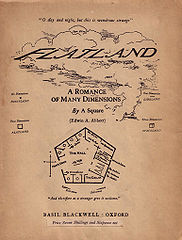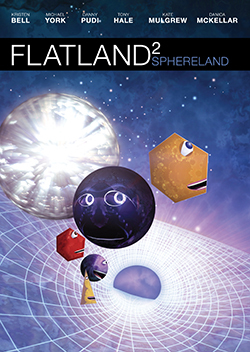As a high-school student, I was torn between two passions: my love of creativity and my love of science. On the one hand I enjoyed writing skits, building and painting sets, and acting onstage in the drama club's productions. On the other I loved that science and mathematics told an amazing, ever-unfolding story of an expanding cosmos.
One geometry assignment showed me the two worlds could combine in ways unexpected and inspiring.
Amidst numerous math problems determining angles, volumes, and areas, my class was assigned to read Edwin A. Abbott's 1884 novel Flatland, the tale of a universe defined only by two dimensions, length and width, and populated by geometric shapes. "A fiction book in math class? About talking shapes?" my classmates and I groaned. How could this thin book written in Victorian times help us on homework or college entrance exams?
 Once I cracked open Flatland, I discovered ideas that appealed to both my passions, the cosmic and the creative. Understanding the allegory of two-dimensional Flatlanders discovering the third dimension sparked questions of how we three-dimensional humans might detect the fourth or higher dimensions. My artistic sensibilities came to life while imagining an alien, flat world. How could these creatures live, play, and build a society like our own? How would the fourth dimension appear to us, and how might we appear to higher-dimensional beings?
Once I cracked open Flatland, I discovered ideas that appealed to both my passions, the cosmic and the creative. Understanding the allegory of two-dimensional Flatlanders discovering the third dimension sparked questions of how we three-dimensional humans might detect the fourth or higher dimensions. My artistic sensibilities came to life while imagining an alien, flat world. How could these creatures live, play, and build a society like our own? How would the fourth dimension appear to us, and how might we appear to higher-dimensional beings?
More importantly, I took the novel's theme of perspective to heart. Perspective can function both as a physical obstacle (Flatlanders cannot see the third dimension, and Spacelanders cannot see the fourth dimension) and as a psychological obstacle (characters cannot see eye-to-eye). It is the scientific perspective that allows us to see beyond our limitations of space and time to understand the evolution of life, the Big Bang, and the structure of the universe at micro and macro levels.
Reading Flatland was one of the most mind-expanding high-school experiences, and I imagine that if my classmates recall anything from geometry, they remember reading this unique book.
Years later I would discover that Flatland wasn't done with me yet. After learning of my dabbling in computer animation, my film-producer friend Seth Caplan asked me, "Have you ever heard of Flatland? We should animate that." Together with filmmaker Jeffrey Travis, we realized that we could potentially create an exciting and thought-provoking adventure to inspire a new generation of students to think creatively about math and science. More than ever before, my two spheres of creativity and science were combining in the biggest film project I had undertaken to date: Flatland: The Movie.
All the hypothetical, imaginative questions I had asked myself in high school now needed answers. Working with a small, talented group of artists and animators, we created an amazing 2D world of fractals and shapes. Talented actors such as Martin Sheen, Kristen Bell, Michael York, and Tony Hale lent us their voices, and the months-long process of painstakingly animating the movie began in earnest. Through many late nights staring at screens of blinking, talking, and emoting squares, circles, and hexagons, I wondered if our Flatland would connect with teachers, students, and the general public.
Seven years after the release of Flatland: The Movie, I can resoundingly answer, "Yes." The movie has been used in thousands of classrooms, translated into a dozen languages, and enthralled audiences at international film festivals. It has been included in an art exhibit at the Pompidou-Metz in France, been screened by the U.S. State Department in Cairo, and won awards at the Berlin MathFilm Festival. It is a great honor when new math teachers tell me they first saw Flatland: The Movie in college, and that they are excited to show it to their young students for the first time.
 Furthermore, this month we present the new Flatland sequel, Flatland 2: Sphereland, to attendees of the 2014 USA Science & Engineering Festival in Washington, D.C. The adventure of the first film continues as the Flatlanders discover that perhaps their universe isn't so flat. We were inspired by the Flatland-follow-up novel Sphereland by Dionys Burger. Returning voice cast Kristen Bell, Michael York, and Tony Hale are joined by Danica McKellar, Danny Pudi, and Kate Mulgrew as new characters encountering mathematical puzzles that call for a scientific perspective beyond conventional thinking.
Furthermore, this month we present the new Flatland sequel, Flatland 2: Sphereland, to attendees of the 2014 USA Science & Engineering Festival in Washington, D.C. The adventure of the first film continues as the Flatlanders discover that perhaps their universe isn't so flat. We were inspired by the Flatland-follow-up novel Sphereland by Dionys Burger. Returning voice cast Kristen Bell, Michael York, and Tony Hale are joined by Danica McKellar, Danny Pudi, and Kate Mulgrew as new characters encountering mathematical puzzles that call for a scientific perspective beyond conventional thinking.
We can't wait to share with the Science & Engineering Festival attendees and get a whole new generation of kids thinking about Flatland and STEM careers.
Come join the Flatland and Sphereland filmmakers and actress/mathematician Danica McKellar for an exciting presentation on the mathematics and creativity behind the films on Saturday, April 26, at 11:30 a.m. at the Lockheed Martin Stage or at booth 2839 all weekend. More info can be found at flatlandthemovie.com.